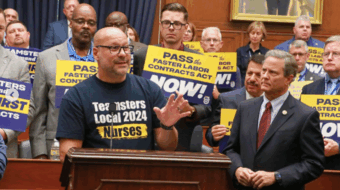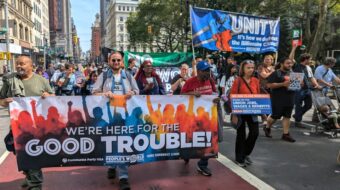
The following article is based on remarks delivered by the author at a meeting of the National Committee of the Communist Party USA in Chicago on November 17, 2018.
The outcome of the 2018 midterm elections was a huge victory for the American people, our multi-racial working-class, and the electoral alliance of Democrats and energized grassroots movements that powered it.
The election victory was historic. Nothing short of the future of our democratic republic was on the line.
Despite GOP gains in the U.S. Senate, their monopoly of government has been broken, and their legislative agenda is dead. The political terrain has been significantly altered for the battles ahead, including the 2020 elections and congressional redistricting.
On the other hand, expectations have grown for passage of a progressive agenda in states where there are a Democratic governor and Democratic majorities in both branches of the legislature, like New York, Illinois, Maine, New Mexico, Colorado, and Nevada.
Imagine the reaction had Democrats lost the House? The mood of the country would have been far different. Grassroots movements would have felt deflated while Trump and the GOP triumphally declared a mandate. Emboldened fascist groups would have openly celebrated.
Instead, this was the most significant “blue wave” since at least 1975, and voter suppression and gerrymandering prevented even more victories, including in Florida, Georgia, and Texas. It is hard to overestimate the impact of the election of hundreds of candidates who emerged from grassroots struggles. These victories open new opportunities to advance a pro-people, progressive agenda.
And grassroots movements have wasted no time diving into new struggles. Stacey Abrams and Andrew Gillum turned the unabashed systemic voter disenfranchisement that robbed them of victories into a rallying cry for broad electoral and voting reforms.
Repudiation of Trumpism
The election results were a significant repudiation of white supremacy, anti-immigrant hate, anti-Semitism, Islamophobia, homophobia, misogyny, and denial of the climate crisis.
Millions of voters acted with alarm in response to a feeling they are living in an increasingly unrecognizable country; where democratic institutions, norms, and rights are at risk; immoral and callous policies are separating families and detaining children; and the diverse social fabric is being ripped to shreds by vile hatred spewing from the White House.
Voter turnout for a mid-term election was the highest in 50 years, and a majority voted against GOP candidates. In total, Democratic House candidates received nearly nine million more votes than GOP candidates.
Despite losing three seats held by incumbents, Democratic Senate candidates got close to 45 million votes and Republicans just 33 million (57 percent to 42 percent).
In addition to flipping 42 seats to win the House majority, Democrats flipped seven governorships, including in the critical Midwestern states of Wisconsin, Michigan, and Illinois, over 330 state legislative seats, majorities in multiple state legislatures, and broke GOP supermajorities in others.
Republican Senate gains took place in so-called “red” or “leaning red” states, a challenging terrain for Democrats to defend. And yet, in every race (except North Dakota and Indiana) Democratic candidates scored over 45 percent of the vote. With stronger statewide infrastructure, including in rural areas, and more effective candidates, Democrats can be competitive.
Some states thought to be out of reach by Democrats just a few years ago are now competitive, including Texas, Arizona, and Georgia. Losing any of these would be a massive blow to the right.
The election results were also a repudiation of right-wing policies, including attacks on democracy, voting rights, health care, education, gun control, collective bargaining rights, environmental protection, and addressing climate change.
Health care coverage, including defense of protections for people with pre-existing conditions, emerged as a critical issue. Voters in the GOP-controlled states of Utah, Nebraska, and Idaho passed ballot measures expanding Medicaid. Sixty percent of voters in Republican-dominated states support the expansion of Medicaid.
The elections were also a referendum on GOP policies at the state level where they made a mess of things, including in Illinois, Michigan, Wisconsin, and Kansas, which conducted the most extreme experiment in free-market capitalism.
In several states, voters rejected Republican policies that have resulted in severe budget crises which decimated healthcare and closed rural hospitals, slashed social programs for the most vulnerable, and produced environmental and public health crises like the Flint water crisis.
Voters also rejected GOP cuts to education and attacks on teachers and their unions—the same policies which sparked a wave of teacher strikes and walkouts earlier in 2018. During the primary elections in Missouri, Democrat and Republican voters defeated the right-to-work ballot initiative.
The elections also reflected broad shifts in the thinking of millions. 317 House districts swung left compared to 2016, moving on average 10 percent. A further 171 districts won by Republicans also moved left. Over 70 percent of voters support Medicare for All, including 52 percent of Republicans. Sixty-six percent of voters support keeping Roe v. Wade as is.
Following the election, Trump became increasingly unhinged with delusions of a “total victory.” His dark mood over the Mueller investigation, obsession with enemies, and flights from reality pose an increasing danger. Trump’s firing of Attorney General Jeff Sessions and installation of a sycophant, Matthew Whittaker, is another effort to obstruct the Mueller investigation and could precipitate a constitutional crisis.
Come January, Democrats will have greater ability to protect the Mueller investigation and authority to conduct inquiries into the 2016 election interference and endless corruption scandals of this administration.
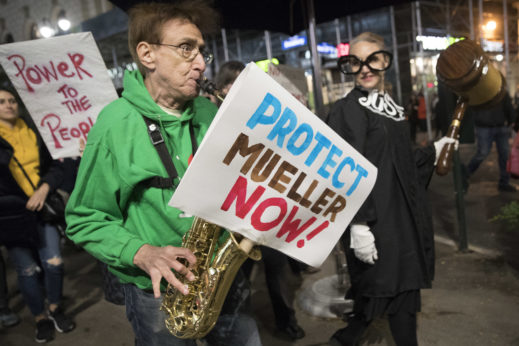
Democrats will also present their legislative agenda, in conjunction with the mass democratic movements, that illuminates their stark differences with the GOP.
In her post-election press conference, incoming House Speaker Nancy Pelosi identified priority issues for action: lowering health care costs; jobs and infrastructure; transparency and oversight; and campaign finance reform.
Pelosi also announced the first legislation to be introduced, HR 1, “would establish automatic voter registration and reinvigorate the Voting Rights Act,” crippled by a Supreme Court decision in 2013. It would take away redistricting power from state legislatures and give it to independent commissions. Other provisions would overturn the Supreme Court’s Citizens United ruling.
The Democratic House Caucus is the most diverse group of legislators ever, with many constituency groups, including the largest, the Progressive Caucus. Differences on a range of issues are sure to arise, including where the Democratic leadership differs with more progressive legislators and mass democratic movements. Building mass movements and grassroots pressure is needed, but so long as the focus remains on isolating the right, differences should never reach a breaking point.
Grassroots movements powered the victory
Incredible grassroots movements, women, people of color and particularly women of color, propelled the election victories. Tens of millions of people, especially first-time voters, were engaged.
Many of those elected were part of a groundswell of candidates from these grassroots movements, protesting one day and running for office the next. Candidates arose from the #MeToo and broader women’s movement, Black Lives Matter and broader racial justice movement, organized labor, immigrant rights, anti-gun violence, LGBTQ, and environmental justice movements. They include Lucy McBath, whose son Jordan Davis was the victim of a racist murder.
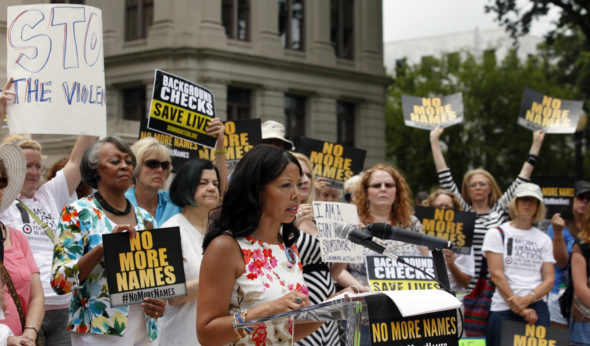
This development has few parallels in our history. The newly elected activist-officials and those in future cycles will help transform legislative processes at every level. Many will remain connected to the mass movements that spawned them.
A comparable period may be following the passage of the Civil Rights and Voting Rights Acts. Then, thousands of African-American officials were elected across the South, and later Mexican Americans and women.
In 2018, women, particularly African-American women, ran and were elected in record numbers at every level of government. Over 100 women are now in the House of Representatives, including the first Native American and Muslim women. Twenty-two women won seats in the Nevada Assembly, making a female majority in the chamber—a historic first for the state. Nevada will be the first state legislature in U.S. history to have more women than men serving.
Three new African-American lieutenant governors, four new African-American attorneys general, and seven new African-American members of the House were elected.
At last count, over 900 union members were elected. About a third of the 120 teachers who ran won election to state legislatures, including some who were engaged in strikes and walkouts earlier this year, according to the American Federation of Teachers.
The National Education Association reported the election of 1,080 educators to state legislatures out of nearly 1,800 who ran. They include the election of current and retired teachers, administrators, support staff, and higher education employees.
The historical campaigns by Stacey Abrams, Andrew Gillum, and Beto O’Rourke inspired millions, especially women, people of color, and youth.
Among the victors were communists and socialists, including to Congress and state legislatures. Their election, mainly in deep “blue” districts, reflects the broad shifts within the Democratic Party, where 57 percent now have a positive attitude toward socialism.
Combating the erosion of democracy
The 2016 and 2018 elections again revealed the limitations and fragility of U.S. democratic institutions and how quickly many are undermined. Among those limitations, first and foremost were restrictions on the right to vote, the undemocratic nature of the electoral college, and the disproportionate representation of the U.S. Senate, where 17 percent of the population elects half of all senators.
Defending and expanding the right to vote is a central battle of our time. Tremendous struggles were waged to combat voter suppression, including throughout the South and on Native American reservations.
Momentous victories included passage of ballot measures to restore voting rights to felons in Florida, establish automatic voter registration and state redistricting commissions, and the election of secretaries of state who will uphold the right to vote.
The right danger is not defeated
Despite the 2018 victories, it is easy to become impatient with the pace of change or get lost in the weeds without a strategic objective. Since 1980, that strategic objective for the Communist Party has been to defeat the extreme right’s domination of government, politics, and culture. In 2018, the extreme right and fascist danger was set back but not defeated.
The Republican Party and the entire right-wing infrastructure are still potent, deeply embedded in all aspects of government, politics, and culture, and have plenty of room to maneuver. They still control the presidency, with direct ties to fascist movements and the right-wing mass media and propaganda industries, the Senate and Supreme Court, and many governorships and state legislatures.
It will take more than one or two election cycles to break their domination of government and the judiciary. We should anticipate a regrouping, ferocious backlash, increased use of bigotry and hate, and further efforts to divide the working class and people and erode democracy.
Trump and the Tea Party movement, backed by billionaire oligarch patrons—including the Mercer family, Sheldon Adelson, and the Koch brothers and their wealthy conservative network—have cultivated a base of supporters numbering in the millions. The extreme right-wing mass media, fascist social media networks, and fundamentalist religious networks have brainwashed those in their embrace.
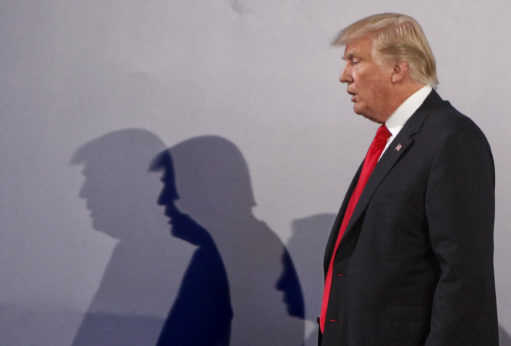
Trump and his ties to domestic fascist movements are part of the ascendancy of the so-called global “alt-right,” including across Europe, in Brazil, and other countries in South and Central America. This danger will persist long after Trump has left the scene.
The strategic objective to build all-people’s unity to oust the right from power and elect in its place a left-center, multi-racial, multi-gender, and multi-class governing coalition has been embraced by a wide range of class and democratic forces and was critical to victories on November 6. It is essential to keep building the broadest unity possible, including left-center unity, and the broad alliance of labor and allied organizations with the Democratic Party.
Advancing leadership of the multi-racial working class, the other core forces of people of color, women, and youth, in alliance with the mass democratic movements, is essential. Building political independence is a central aspect, including coalition candidates from organized labor and working-class communities, the other core forces, mass movements, and socialists and communists. This underscores the critical importance of involvement in the electoral arena.
The campaign of fear and hysteria
By creating hysteria and anxiety around the migrant caravan, Trump and the GOP successfully mobilized a base of supporters in the so-called “red” states, especially in small towns and rural areas. Democrats often appeared to be caught flat-footed in their response.
The ads portraying the migrant caravan as a national security threat funded by Jews and Democrats were the most open and despicable appeals to racism, xenophobia, anti-Semitism, and Islamophobia that we have seen yet. The ads were inspired directly from the so-called “alt-right” fascist playbook. Trump deliberately targeted these states to hang onto the GOP Senate majority.
This hysteria and hate also created the atmosphere which led to three domestic terror attacks before the election.
The Trump-GOP racism, anti-Semitism, misogyny, and xenophobia cut both ways. They were a bridge too far for millions. The ads and terror attacks generated a considerable alarm, boosted turnout, and drove many moderate white voters, including many white women and working-class suburbanites, to vote for Democratic candidates.
The Trump and GOP extreme hate and fear are facilitating a realignment of political forces. The GOP is a party of open white supremacy, conspiracies and paranoia, theocracy, and climate and science denial.
In suburban communities and places like Kansas, where the GOP was ousted from the governorship, it has moved far beyond mainstream conservatism, causing an erosion of the party’s support. Bankrupt of ideas, the GOP has a narrowing base, is descending deeper into crisis, and is becoming what George Conway called a “cult of Trump.”
Meanwhile, the Democratic Party base and its alliances are expanding and becoming more diverse.
However, tens of millions of white voters are still under the sway of toxic hate from Trump, the GOP, the vast right-wing mass media propaganda, fascist social media, the NRA, think tanks, and right-wing fundamentalist white evangelical churches. This 24 hour-a-day propaganda machine keeps millions in a political cocoon of lies, conspiracies, and paranoia. This base of supporters is not yet breaking with Trump.
There is no getting around taking on this toxic stew of hateful ideas and organizing a united multi-racial movement against racism, anti-immigrant hate, misogyny, anti-Semitism, homophobia, and Islamophobia.
Without decisive unity, and making further inroads among those white voters still supporting the GOP, and without mobilizing much higher rates of voter turnout in every community, our multi-racial working class will not be able to play a leading role in the social transformation to a more equitable society.
Contesting everywhere
The electoral alliance that includes the Democratic Party, labor, racial and gender justice movements, immigrant rights, LGBTQ and other democratic movements can win on a 50-state, 3,000-county strategy and by building independent grassroots movement infrastructure everywhere and the left and independent media to contest in the battle of ideas.
It would be a mistake to base change solely through reliance on demographic shifts, as some Democratic strategists have argued. Such an approach abandons the essential need for multi-racial unity and abdicates the fight against racism. This approach sees building a winning coalition only among people of color, women, and young people. It concedes large swaths of white voters, including white working-class voters, to the embrace of the right.
I believe this is what mainly happened. For years, the Democratic Party and many allied organizations either neglected or abandoned organization in many of the less racially diverse states, suburbs, exurbs, small towns, and rural areas and focused on racially diverse urban areas with heavy union density.
The Democratic Party also retreated from seriously contesting in Southern states outside of Florida during presidential elections, despite the presence of a large African-American electorate and some states with large Latino and Native American populations.
In many GOP-dominated states, many offices have been going uncontested for years. In 2014, half of Oklahoma’s state legislative offices went unchallenged by Democrats.
Simultaneous with the weakening of the Democratic Party at the grassroots, deindustrialization and the decimation of the labor movement and social fabric in many communities meant the primary influence was too often the GOP, right-wing media propaganda, the NRA, and right-wing evangelical churches. These factors also contributed to historically low voter turnouts.
Cases in point are the congressional districts that stretch over suburban and exurban areas west of Chicago that were ironically gerrymandered as GOP districts by the Democratic-dominated state legislature.
These districts are made up of working-class communities, with pockets of poverty, alongside some very wealthy municipalities. They are increasingly multi-racial with the influx of large numbers of immigrants and working-class residents displaced by Chicago gentrification.
They were historically the heart of the GOP state machine and the Democratic Party all but abandoned them until an independent Democratic candidate ran for Congress in 2006 in the 6th CD and won 44 percent of the vote.
The base of voters who identified as Democrats was there all along, but they were isolated and figured they were alone.
In 2005, under the leadership of Howard Dean, the DNC instituted the 50-state strategy. Funds were invested in state organizations, but beginning in 2009 they were slashed.
The Democratic Party began seriously contesting in more suburban districts in 2006. After the 2016 election, the DNC took stock of its losses and with the election of Tom Perez and Keith Ellison into leadership, the 50-states, 3,000 country strategy was resurrected.
The same thing happened with state legislative seats, too. But in the recent period, the Democratic Party Legislative Committee and allied groups like Planned Parenthood and League of Conservation Voters poured money and resources into building infrastructure and assisting local organizations.
Spurred by the grassroots movements, candidates contested seats at every level beginning with the elections in Virginia last year. For the first time in 25 years, Democratic candidates challenged in every congressional district in Texas.
In Illinois, voters in both suburban Chicago districts elected Democrats in 2018, including Lauren Underwood, an African-American nurse elected in a majority white district. Indivisible chapters in Chicago provided 200 canvassers during GOTV and did half the canvassing in one county.
An alliance of 27 grassroots organizations including Indivisible chapters, called “Coalition for a Better 6th,” has been founded to build grassroots infrastructure to protect and expand these electoral gains.
Elsewhere, the wave of teacher strikes and walkouts helped to revive dormant Democratic Party organizations in Oklahoma, Kansas, and West Virginia and energize voter turnout in Arizona.
Ultimately, there is no way to build a governing coalition, win a Democratic majority in the U.S. Senate and a substantial electoral college majority without winning many states where the demographics are less diverse. In the Deep South, with large percentages of African-American voters, and states with significant Latino and Native American populations, where black-brown-white unity is essential for victory, this is also true.
Making substantial gains among white voters who voted for the GOP and Trump or are politically disengaged and building grassroots movements and infrastructure to mobilize voters in all communities at rates surpassing the November 6 levels is imperative.
Active, vibrant, connected Communist Party clubs at the grassroots are an indispensable part of that mix.
But for now, let’s celebrate this great achievement, and the tireless work of millions who made it possible. On to greater victories in 2020 and beyond!




